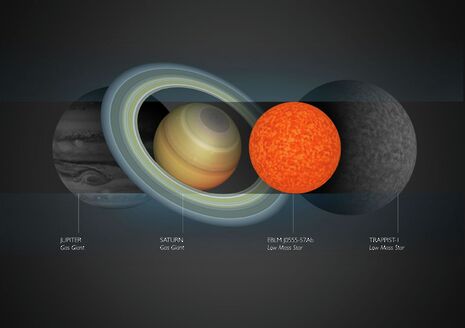University astronomers discover the smallest-ever star
The star is just slightly larger in size than Saturn, and could be used to detect other Earth-sized planets

A team of astronomers from the University of Cambridge and other universities worldwide have discovered the smallest star ever measured.
The newly measured star, which astronomers have named EBLM J0555-57Ab, is just slightly larger than the planet Saturn, and the gravitational pull on it is about 300 times stronger than what we feel on Earth.
EBLM J0555-57Ab is located about six hundred light years away, yet because of its location within a binary system, astronomers were able to identify it as it passed in front of its much larger companion.
The discovery was published in a letter to the editor of the journal Astronomy & Astrophysics late last month.
According to astronomers, the star is likely to be the smallest a star could possibly be, as it has just enough mass to enable hydrogen nuclei to fuse into helium, without which it would transition into a brown dwarf.
Hydrogen fusion is also what powers the sun, and is a process which scientists are attempting to replicate on Earth as a powerful source of energy.
Small and dim stars like EBLM J0555-57Ab are also being used by astronomers to detect planets the same size as Earth, which may have liquid water on their surfaces.
However, despite the fact that these type of stars are the most numerous stars in the universe, they are poorly understood precisely because they are difficult to detect, hence the importance of this discovery.
The lead author of the study published in Astronomy & Astrophysics is Alexander von Boetticher, a Master’s student at the Cavendish Laboratory and the Institute of Astronomy.
Other Cambridge academics involved in the discovery were Laetitia Delrez, Dr Amaury Triaud, and Professor Didier Queloz.
Emphasising the importance of the study, Dr Triaud said that: “the smallest stars provide optimal conditions for the discovery of Earth-like planets, and for the remote exploration of their atmospheres”.
Yet, Dr Triaud continued: “before we can study planets, we absolutely need to understand their star; this is fundamental”.
 Comment / Plastic pubs: the problem with Cambridge alehouses 5 January 2026
Comment / Plastic pubs: the problem with Cambridge alehouses 5 January 2026 News / Cambridge businesses concerned infrastructure delays will hurt growth5 January 2026
News / Cambridge businesses concerned infrastructure delays will hurt growth5 January 2026 News / Cambridge academics stand out in King’s 2026 Honours List2 January 2026
News / Cambridge academics stand out in King’s 2026 Honours List2 January 2026 Interviews / You don’t need to peak at Cambridge, says Robin Harding31 December 2025
Interviews / You don’t need to peak at Cambridge, says Robin Harding31 December 2025 News / AstraZeneca sues for £32 million over faulty construction at Cambridge Campus31 December 2025
News / AstraZeneca sues for £32 million over faulty construction at Cambridge Campus31 December 2025









